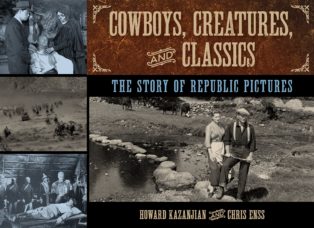Enter now to win a copy of
Cowboys, Creatures and Classics: The Story of Republic Pictures

A pair of frantic, disheveled riders race side by side down a dusty, sun-scorched path. Suddenly they plunge into a wooded area. Branches slap at them, but neither dares slow his mount’s gait. They break through the other side, each still jockeying for lead position. The rider barely lagging behind now extends his arm out to grab the young man inches from him. The young man spurs his horse along faster and pulls away from the man trying to catch him. Ahead in the near distance, the crude path ends abruptly, giving way to a rocky cliff with a raging river far below. The two riders continue on fast, unaware of the danger. The young man is the first to leap off the precipice, his horse still under him. The rider behind him doesn’t hesitate but pushes his roan harder. The two fly off the cliff with great speed and plummet into the water.
The daring riders find their way to the surface. They’re dazed, but alive. The animals are alive as well, and they scramble to the water’s edge and hastily step out onto dry land.
After fighting the river’s strong current, both men manage to reach a sandy bank and drag themselves out of the water. They are exhausted and drenched. The young man struggles to stand up and, once he finds his footing, hurries off after his horse. The cowboy that was chasing him hasn’t any strength left. He lies flat on his back on the bank staring up at the cliff where he dropped, contemplating how he could have survived such a fall.
That particular stunt was executed by legendary rodeo champion turned stuntman Yakima Canutt for the film The Devil Horse starring Harry Carey. Canutt was one of the most well-known members of the group of dedicated men and women who were willing to risk their lives for little pay and no screen credit—the stunt person. When a script called for rough and tumble action such as a fistfight, car crash, or jumping off a seventy-two-foot cliff into a ravine without a net or soft landing pad, a stunt person was required.
Republic Pictures had a stable of daredevils who lived to perform death-defying feats that kept audiences on the edge of their seats. Yakima Canutt and the other stunt staff revolutionized the art and helped make Republic features and serials some of the most exciting and profitable works in the motion picture industry.
Canutt appeared in more than two hundred films during his on-screen career, but he didn’t start out wanting to be in the movies. He broke horses and for a while was content with the work. Canutt was born in Colfax, Washington, in 1895. He attended school until he was twelve, and then he went to work full-time on a ranch. He won his first world championship cowboy award in 1917. Canutt became one of the best-known saddle and bareback bronc riders on the rodeo circuit. He was often among the top money winners in what was then the roughest of all competitive sports.
In between rodeos, he managed to break horses for the French government’s use in World War I. He then dropped the rodeo circuit temporarily to enter the Navy and served aboard a minesweeper. In 1919, he regained his world championship crown, the second of the five total he earned.
Canutt headed for the movies in 1923. He did forty-eight silent westerns before talkies took over. He didn’t have a voice for talkies, so he made the leap to stunt work. He excelled in the field. He and John Wayne developed a way to stage on-screen fights to make them look more realistic. Prior to the development of the choreographed screen brawl, the good guy and the villain threw unrealistic punches at one another and wrestled and flailed around. A Canutt screen fight involved positioning of the camera at angles to the participants, rather than straight on, and the camera would often face one of the participants. That camera angle gave the perception of bone-crushing punches landing on the jaw.
Not only did Canutt perform amazing stunts for the numerous pictures he was in, but he also choreographed stunt sequences for many movies in which he wasn’t a part of the on-screen talent. Some of the movies Canutt choreographed stunt sequences for included Flying Tigers, Spy Smasher, and Jungle Girl.
Canutt became a second-unit director in addition to stuntman and stunt coordinator. In that capacity he directed breathtaking action sequences of some of Hollywood’s most spectacular films; Spartacus and Ben Hur were two of those films. He also directed a number of low-budget westerns.

To learn more about the many films Republic Pictures produced read
Cowboys, Creatures and Classics: The Story of Republic Pictures

